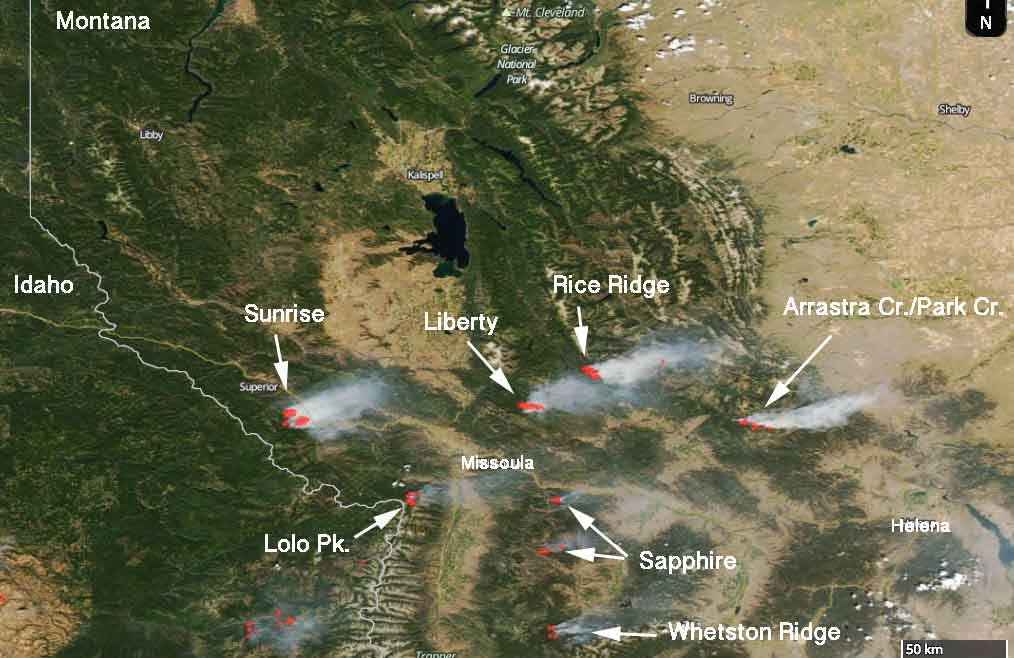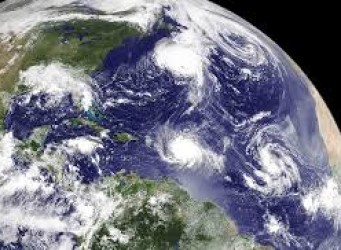A couple of weeks ago I wrote about how the National Flood Insurance Program (NFIP) is $25 BILLION in the hole. Since this program is funded by OUR tax dollars, it is we citizen tax payers that pay for these natural disasters. We should all be supportive that this program is in place to help and support those that suffer from weather disasters. “But for the grace of God go I.” Most people agree that we have a responsibility to collectively support each other in times of horrible disasters and would want that for ourselves if this should occur to us.
The following article indicates that the dollars for fighting fires are experiencing the same deficit as the NFIP and needs to be addressed by Congress.
Unfortunately, these horribly destructive weather events are happening more frequently due to a warming climate and causing increasing economic expense. Of course, the impact on individuals is horrific too.
As a follow up to the NFIP deficit, the financial impact is not just limited to flooding. Fires are an equally dangerous catastrophe. Right now, today, there are huge fires raging in Montana. The last several summers have also been horrific and caused enormous damage.
Lack of rain that makes circumstances ripe for fires, large ones and those that are more limited in scope, are a direct consequence of a warmer climate. The impact goes well beyond the cost of loss to property. Of course there is the cost of fighting the fires. As the following article indicates a loss of life is a horrible consequence . In this case, two fire fighters have died. We all grieve for them and their families as they paid the ultimate price in public service protecting the rest of us and our property.
There are other consequences that aren’t as obvious. Fires create huge amounts of smoke. I‘ve seen smoke plumes from satellite observations showing huge swaths of landscape that are being impacted like the one below that was taken July 31, 2017. This phenomenon has enormous impact on peoples’ health. Those with lung disease such as asthma are hugely impacted. Inhaling smoke can cause all sorts of other health issues such as heart disease.
I was talking to a neighbor this week who has a son in Whitefish, Montana (a place I’ve been) who wants to go for a visit. Her son told her not to come due to the smoke and the impact it would have on her health. He said that Whitefish, which depends greatly on revenue from tourists, is suffering substantially because the tourists aren’t coming right now. This is only one example of the ripple effect that we might not realize and is emblematic of how a warming climate will have tentacles that go deeply below the obvious consequences.
One last thought. The forests that are burning are releasing CO2 into the atmosphere that had previously been stored in these trees. In addition, not having the trees to absorb CO2 from the atmosphere increases the rate of warming. This is a similar phenomenon as the melting of the arctic permafrost and the ice at the poles. The permafrost actually releases CO2 that has been stored in it. As for the melting arctic ice, without it more heat is absorbed in the atmosphere instead of being reflected back to space.
“Montana is bearing the brunt of fiery devastation. More than 30 fires are burning across the state, 11 of which are classified as large. Hundreds of people have been evacuated, and two firefighters have been killed.”
“Fire seasons in the United States are 80 days longer on average than they were in 1970 and burn twice as many acres”
The “director of the Office of Wildland Fire at the Interior Department — agreed that climate change is a driving reason behind today’s longer fire seasons.”
“Temperatures in Montana have increased about 2 degrees Fahrenheit since the early 20th century, and models project that they could exceed historical averages by 2050”
“Warmer temperatures are expected to shift some snowfall to rain and trigger earlier spring runoff. In addition, the intensity of droughts is expected to increase.”
The West Burns as Lawmakers Struggle to Fix Wildfire Policy
But it’s unclear if past disagreements that hamstrung Forest Service budgets by redirecting funding into empty accounts for firefighting can be overcome now that Republicans, including many from the West, are operating the levers of government.
“We do have a new Republican-controlled Congress and executive branch, so that’s encouraging,” said Diana Madson, executive director of the Mountain Pact. “However, it’s hard to really know.” There is no shortage of ideas on how to fix the problems. In June, Reps. Mike Simpson (R-Idaho) and Kurt Schrader (D-Ore.) introduced H.R. 2862, the “Wildfire Disaster Funding Act.” The bill, similar to legislation introduced with the same name in 2015, would allow the Forest Service to access disaster funding managed by the Federal Emergency Management Agency, when fighting wildfires exceeds the cost of its 10-year average.
Last month, Sens. Mike Crapo (R-Idaho) and Sherrod Brown (D-Ohio) included language in Section 102 of the National Flood Insurance Program bill to amend the Robert T. Stafford Disaster Relief and Emergency Assistance Act. The provision would allow federal agencies to tap into disaster relief dollars when fighting fires (E&E Daily, July 19).
Both bills would reduce “fire borrowing,” a practice by which the Forest Service transfers money from its non-fire accounts to pay for firefighting. The agency has done that 12 times since 2002. The Forest Service estimates that if no fix is found, 67 percent of the budget — including almost $700 million in non-fire program dollars — could be devoted to suppressing fire by 2025. Lawmakers’ efforts have come as a representative from the Forest Service confirmed yesterday that the Trump administration supports finding a fix for the fire borrowing problem. Victoria Christiansen, the Forest Service’s deputy chief for state and private forestry, told the Senate Energy and Natural Resources Committee that the Trump administration is “absolutely committed” to the effort (E&E Daily, Aug. 4). But it’s unclear if that will actually happen. “It’s promising that it’s been introduced in both the House and Senate … but I don’t know how much of appetite there will be for bipartisan legislation with everything else going on,” said Madson. Cecilia Clavet, the Nature Conservancy’s senior policy lead on fire and forests, expressed optimism about finding a flexible solution. The Nature Conservancy is part of the Partner Caucus on Fire Suppression Funding Solutions, a bipartisan coalition of conservation, sportsmen’s and recreation groups. Many of those organizations support the “Wildfire Disaster Funding Act” and the Crapo-Brown language in the flood insurance bill. “We’re in the same place we’ve been,” Clavet said. “There is general agreement that we want to fix the problem, but it’s just which one is the right approach, and at the end of the day, we need a comprehensive solution that works.” Challenges remain. One is the desire by some lawmakers to tackle a fix for the way wildfire suppression is funded, while also boosting efforts to treat more acres of forest. A bill by Rep. Bruce Westerman (R-Ark.), H.R. 2936, the “Resilient Federal Forests Act,” would ease environmental hurdles for forest-thinning projects. It’s expected to pass the House but faces a less certain future in the Senate. Environmental groups oppose provisions that would allow up to 10,000 acres of land at risk for fire to be thinned with less-rigorous environmental reviews (E&E Daily, June 23). Different interest groups often come to the table with different perceptions of how forest restoration work should be done. Some want more logging for commercial purposes; that’s a deal-breaker for others. “Most of us believe there needs to be significant forest restoration for wildfire prevention and forest health, but there are different definitions of what that means,” Madson said.
Meanwhile, fire rages across the West.
Hot, dry and windy conditions are expected to persist in Montana, and fire danger is expected to remain high across much of the West through the summer.
Montana is bearing the brunt of fiery devastation. More than 30 fires are burning across the state, 11 of which are classified as large. Hundreds of people have been evacuated, and two firefighters have been killed.
“We’re having discussions now in early August that we normally have in early September, so we have a long ways to go yet in this fire season,” said Sen. Steve Daines (R-Mont.), speaking at the Senate Energy and Natural Resources Committee hearing yesterday. “We do need to address how we fund and prepare communities for wildfires.”
His comments were echoed by committee members on both sides of the aisle, who uniformly expressed frustration that previous legislative fixes have not gained traction. “This just cannot continue,” said Sen. Ron Wyden (D-Ore.).
Fire seasons in the United States are 80 days longer on average than they were in 1970 and burn twice as many acres, according to the Forest Service. Agency scientists say the changing climate is a major factor driving larger and longer fire seasons.
In response to a question by Sen. Al Franken (D-Minn.), all of the witnesses — including Christiansen with the Forest Service and Bryan Rice, director of the Office of Wildland Fire at the Interior Department — agreed that climate change is a driving reason behind today’s longer fire seasons.
Temperatures in Montana have increased about 2 degrees Fahrenheit since the early 20th century, and models project that they could exceed historical averages by 2050, according to NOAA’s National Centers for Environmental Information.
Warmer temperatures are expected to shift some snowfall to rain and trigger earlier spring runoff. In addition, the intensity of droughts is expected to increase.
Future conditions under climate change mirror what happened this year in Montana. Drought has been a major reason behind the state’s current fires, said John Grassy, communications officer with the Montana Department of Natural Resources and Conservation.
He said everything looked good until May, when temperatures spiked and the rains didn’t come. A month later, much of the eastern side of the state was in drought. Today, 85 percent of Montana is facing dry conditions, with nearly 12 percent under “exceptional drought,” the highest intensity, according to the U.S. Drought Monitor.
“All of this has combined to dry fuels out,” Grassy said. “And that’s really what sets the stage for bigger, faster-moving fires.”




